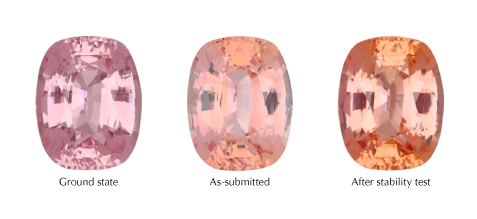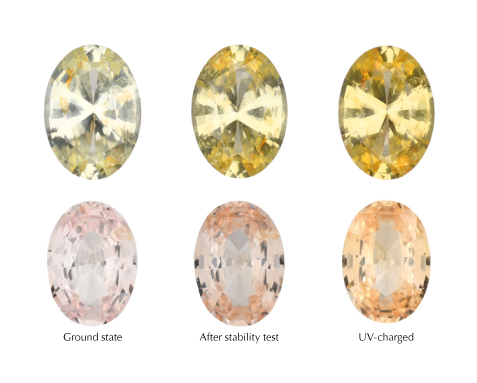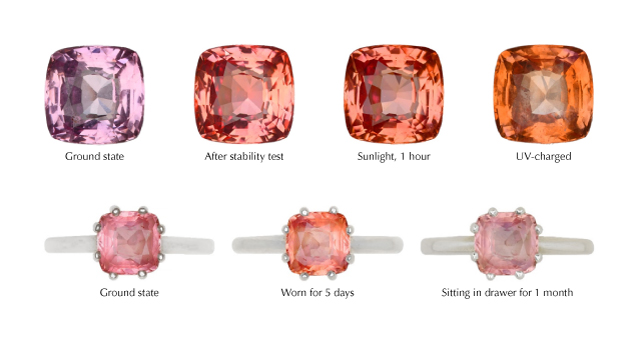An Update on Sapphires with Unstable Color
December 12, 2022

GIA has been performing color stability testing on some sapphires for decades (Crowningshield, 1969). More recently, the stability test has been implemented to identify pink sapphires that can be charged with UV light to create a temporary change of color into the orangy pink to pinkish orange range of padparadscha sapphires or even more orange in appearance. A few hours of exposure to intense incandescent illumination will cause the unstable orange component to fade away, returning the stone to a pink appearance. A sapphire will only be characterized as a padparadscha if the color is acceptable after this stability test. Temporary, unstable orangy pink to pinkish orange coloration does not qualify for the padparadscha characterization if the stone shows coloration outside of this range after the stability test. This change will also occur upon exposure to sunlight, although it takes longer. The color stability test and observations above are described in some detail by Nassau and Valente (1987), Krzemnicki et al. (2018), Smith et al. (2019), Hughes (2022), Wang et al. (2022), and Tsai et al. (2022).
However, GIA has observed that some sapphires react to the color stability test by gaining orange or yellow coloration upon exposure to incandescent light (figure 1). Some pink sapphires might shift to a padparadscha color or even to pure orange, and the saturation of pale yellow sapphires can increase (figure 2).

This orange intensifying reaction is due to the small component of UV light present in the incandescent light used. The UV component creates unstable color centers at the same time they are being destroyed by visible wavelengths of light. If one of these sapphires is stored in a dark place for an extended period, it will fade to the ground state, typically purplish pink, pink, or pale yellow. This ground state can also be achieved by heating (>150°–300°C) or exposure to intense white LED light with no UV component. Subsequent exposure to any light source containing UV—including sunlight—will again show the orange or yellow color (figure 3). This behavior of gaining color during the stability test has been observed in all color-unstable sapphires used in this research project after fading to their ground state under intense LED illumination or when left in the dark. While this is not part of GIA’s normal testing procedures for color-unstable sapphires, it is expected that any color-unstable sapphire could behave similarly and gain color during the stability test to some extent, depending on its initial color (e.g., if left in the dark for extended time). Further, color instability may not always be identified by the stability test if the initial color is close to that produced by exposure to incandescent light. The property of changing color with exposure to UV is referred to as tenebrescence, or reverse photochromism. Tenebrescent stones are known to fade back to their original color when exposed to sunlight.

These observations raise an important question about how gemological laboratories should determine the color of tenebrescent sapphires, and which color should be used to describe the stone. In GIA’s experiments, the color observed after the color stability test is very similar to what was observed after exposure to daylight, which would be expected if set in jewelry and worn frequently. Given this, and given the need for a consistent and easily accessible standard, the color after the incandescent light stability test is the color indicated by GIA on colored stone reports for these sapphires. This is the case regardless of whether a sapphire loses or gains yellow/orange color during the test. Full results of GIA’s research into this important matter are currently being prepared for publication in Gems & Gemology in the near future.
Aaron Palke is senior manager of research, Shane McClure is senior director of identification, and Nathan Renfro is senior manager of colored stone identification, at GIA in Carlsbad, California.
Crowningshield R. (1969) Developments and Highlights at the Gem Trade Lab in New York: X-ray bombarded sapphires. Gems & Gemology, Vol. 13, No. 2, p. 57.
Hughes E.B. (2022) Gem News International: Yellow sapphires with unstable color. Gems & Gemology, Vol. 58, No. 2, pp. 259–260.
Krzemnicki M.S., Klumb A., Braun J. (2018) Unstable colouration of padparadscha-like sapphires. Journal of Gemmology, Vol. 36, No, 4, pp. 346–354.
Nassau K., Valente G.K. (1987) The seven types of yellow sapphires and their stability to light. Gems & Gemology, Vol. 23, No. 4, pp. 222–231, http://dx.doi.org/10.5741/GEMS.23.4.222
Smith C.P., Chaipaksa M., Perlmutter A., Vasquez L., Zellagui R., Che S. (2019) Heated sapphires with unstable colour centres. Journal of Gemmology, Vol. 36, No. 7, pp. 602–604.
Tsai T.H., Wang Z., Takahashi H. (2022) Reversible photochromic effect in natural gemstone sapphires. Optics Letters, Vol. 47, No. 22, pp. 5805–5808, http://dx.doi.org/10.1364/OL.474838
Wang Z., Tsai T.H., Takahashi H. (2022) Rapid screening of a photochromic padparadscha-like sapphire using absorption spectroscopy. Applied Optics, Vol. 61, No. 27, pp. 8108–8114, http://dx.doi.org/10.1364/AO.460718
.jpg)


